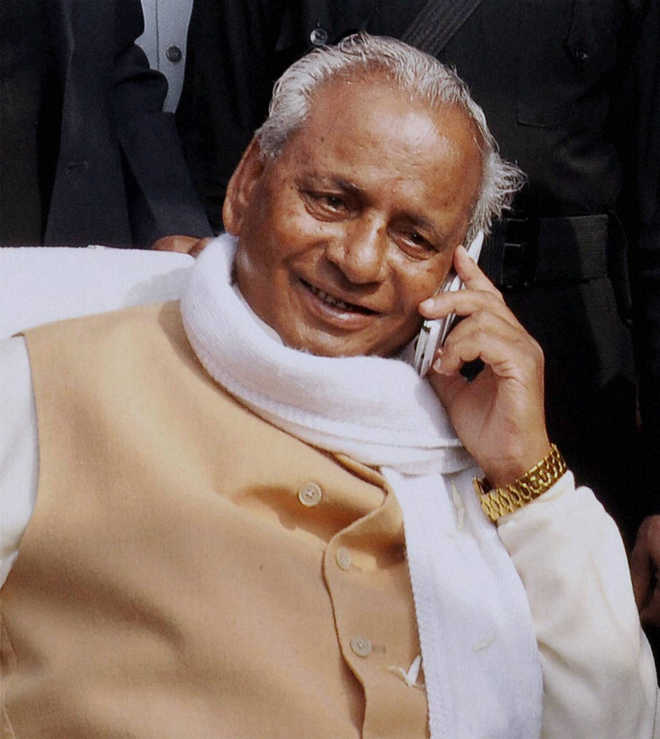
BJP’s OBC face Kalyan Singh was also the first BJP Chief Minister of Uttar Pradesh (from June 1991 to December 1992).
Former Chief Minister of Uttar Pradesh and former Governor of Rajasthan, Kalyan Singh was once the tallest leader of BJP in Hindi belt.
Born on January 5, 1935 in Aligarh, Kalyan Singh belonged to a family of farmers and was associated with the Rashtriya Swayamsevak Sangh (RSS) from his early years.
He grew up to become a teacher and then entered politics. He contested his first election in 1967 on Jana Sangh ticket and reached the state assembly. He won nine state elections and became a minister for the first time in 1977.
The 89-year-old leader was a BJP leader who played a key role in the Ayodhya movement.
The OBC face of the BJP, Singh was also the first BJP Chief Minister of Uttar Pradesh (from June 1991 to December 1992).
In his first brief stint, he made his mark as an able administrator and an efficient leader who took full responsibility for the demolition of the Babri Masjid instead of blaming the bureaucracy.
He was highly respected by his allies and even the idea of a replacement for him was considered nothing short of blasphemy in the BJP at that time.
As he stood in the state assembly, the opposition leaders sat down. His speeches were heard with silence as disruption was not the order of the day till then.
Kalyan Singh’s government fell on the day the Babri Masjid was demolished, but Singh emerged as the tallest Hindu leader, serving a day’s sentence when he came out of Tihar Jail, failing to stop the demolition. To stay, signified a victory.
Apart from being an advocate of Hindutva, Singh was also recognized as a unique OBC leader.
In the early 90s, there was politics between ‘kamandal’ (Hindutva) and ‘mandal’ (reservation) and Singh was completely friendly on both the issues.
As a politician, Singh was not known to settle for short-term gains.
Soon after the infamous State Guest House incident of 1995, he vehemently opposed the BJP which supported the Mayawati government in UP.
However, since the decision was taken at the highest level in the BJP at the time, Singh did not oppose it, though he never attempted to articulate his displeasure.
Again in 1997, when the BJP forged an alliance with Mayawati and the now famous rotation basis for the chief minister’s post, Singh was upset.
Six months later, when Mayawati handed over the chief minister’s post to Singh but pulled out of the alliance, leaving the BJP in a minority, it was Singh’s determination to win a majority for her government that put her to a crucial test in the assembly. – a test that led to violence and split between the BSP and the Congress.
The government survived, Mayawati was devastated, while the politics of alliance and compulsion started in full swing in UP.
However, Singh’s second term as chief minister, which began in September 1997, was marked by political turmoil.
The coalition partners – the now defunct Democratic Congress and the Democratic Bahujan Samaj Party – had slipped into the bargaining model.
There was a ruckus within the BJP itself and the voices of discontent gradually intensified. With several controversies and his deteriorating relationship with the BJP’s central leadership, Singh eventually left the party in 1999.
After this he formed his own National Revolution Party and befriended Mulayam Singh Yadav.
Even though he may not have benefited politically from the alliance, his exit ensured that it took nearly a decade and a half for the BJP to return to power in Uttar Pradesh.
Singh, affectionately called ‘Babuji’ in political circles, remained popular among BJP workers even after he quit the party twice in 2009.
Even when he was out of the BJP, senior party leaders continued to visit ‘Babuji’ in the dark of night, while party workers went to his Mall Avenue residence during the day.
His birthday celebrations on 5 January used to bring together leaders of all political parties.
Singh was appointed as the Governor of Rajasthan in 2014.
His elder son Rajveer Singh is an MP while his grandson Sandeep Singh is a minister in the Yogi Adityanath government.
Singh retired from his governorship in 2019 and lived a quiet, retired life through the steady stream of visitors at his Mall Avenue residence in Lucknow.
His demise has left a void in UP politics – which will not be filled soon. Babuji’s demise will be a personal loss for lakhs of party workers.
Read also | Former Uttar Pradesh Chief Minister Kalyan Singh dies at the age of 89
Read also | Kalyan Singh: When he left the post of UP CM for Ram temple
.